French Oddity: 1960 Panhard PL 17
If you’re the type who is always on the hunt for oddball cars, boy do I have one for you! The French brand Panhard is likely best known for the odd looking, but advanced Dyna Z. If the Dyna just isn’t odd enough for your tastes, Panhard offered another car that was even more unusual. This 1960 Panhard PL-17 is without a doubt one of the oddest cars I have seen in a while and I absolutely love it! This one needs a complete restoration and could prove to be a difficult project, but if you’re up for the task you can find it here on eBay in McMinnville, Oregon. Special thanks goes to Jim S for the tip!
When the PL 17 was introduced in 1959 it wasn’t just odd, it was an incredibly efficient and capable car. Power came from an 850cc boxer 2-cylinder, which was good for about 40 hp. For the size of car this doesn’t seem like much power, but the car was surprisingly lightweight and the odd looking design was quite aerodynamic. Looking at this car you might think that the hood scoop and bulge have to hurt efficiency and I’m sure they do, but they aren’t original. A previous owner installed a VW Type I motor, which must have required making more hood clearance and improved ventilation. I would say they were trying to improve performance, but the VW boxer 4 isn’t all that much more powerful than the original 2-cylinder. I would guess the original engine was damaged beyond repair and finding a replacement wasn’t possible, so they installed the only engine they could make fit.
I can’t help but wonder what impact the engine swap has had on this car. In original trim, these were actually quite nimble. They might have not had a lot of power, but the 1,700 pound weight helped handling and performance significantly. In 1961 three PL 17s proved how quickly they really were when they took all three podium positions at the Monte Carlo Rally. While I’m sure the rules were on their side, this was no small feat.
Finding parts for this car could be a challenge. Not only is it French, but these were never great sellers. Shortly after the PL 17’s introduction, Citroen bought out Panhard’s automobile division. Citroen struggled to price the PL competitively and the use of exotic materials like aluminum made it that much more difficult to turn a profit. If you’re alright with leaving the VW motor under the hood, it should prove to be cheaper and easier to get and keep running. The interior is going to need a considerable amount of work, but hopefully all the hard to find pieces are here.
This one might prove to be a difficult project, but when will you see another VW-powered French car that is this odd? I guarantee you’ll never see another one anywhere! I would just be sure to check out the engine bay carefully and make sure the swap was done properly. So would you leave the VW engine in place or would you find the correct Panhard unit?
Auctions Ending Soon
 2002 Subaru Impreza WRXBid Now2 days$333
2002 Subaru Impreza WRXBid Now2 days$333
 1975 Chevrolet Corvette ConvertibleBid Now2 days$4,000
1975 Chevrolet Corvette ConvertibleBid Now2 days$4,000
 1964 Ford F-100 Camper CustomBid Now2 days$2,000
1964 Ford F-100 Camper CustomBid Now2 days$2,000
 2006 Jeep Wrangler SportBid Now4 days$10,500
2006 Jeep Wrangler SportBid Now4 days$10,500
 1974 Datsun 260ZBid Now6 days$750
1974 Datsun 260ZBid Now6 days$750
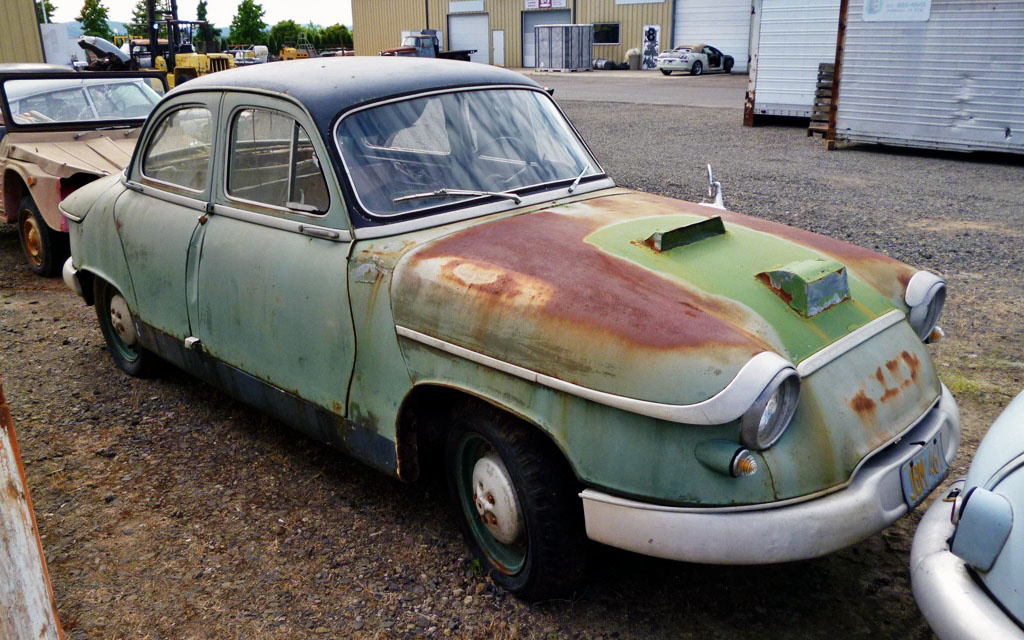
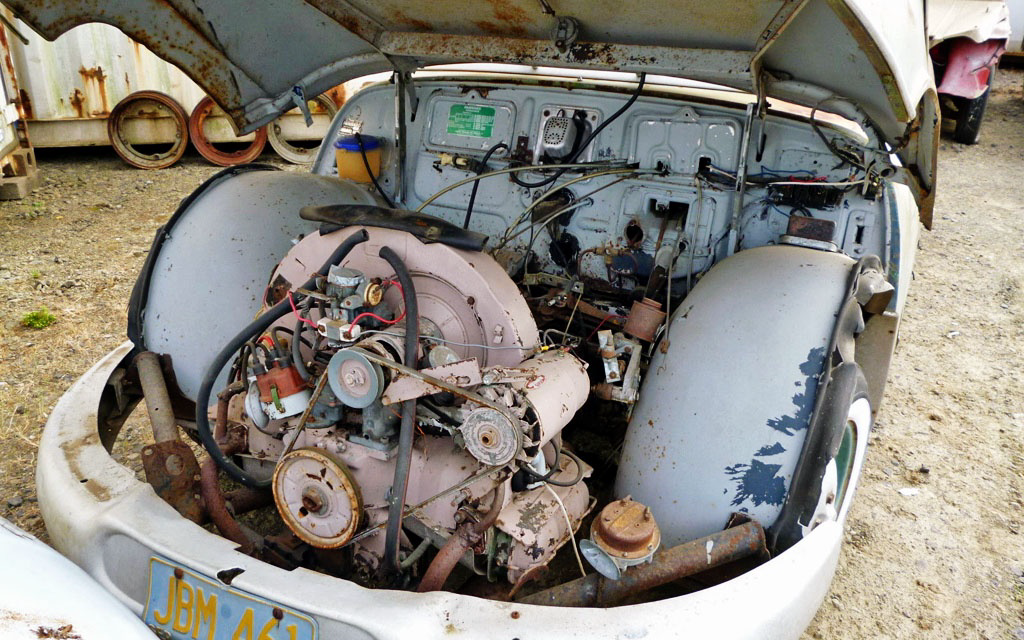
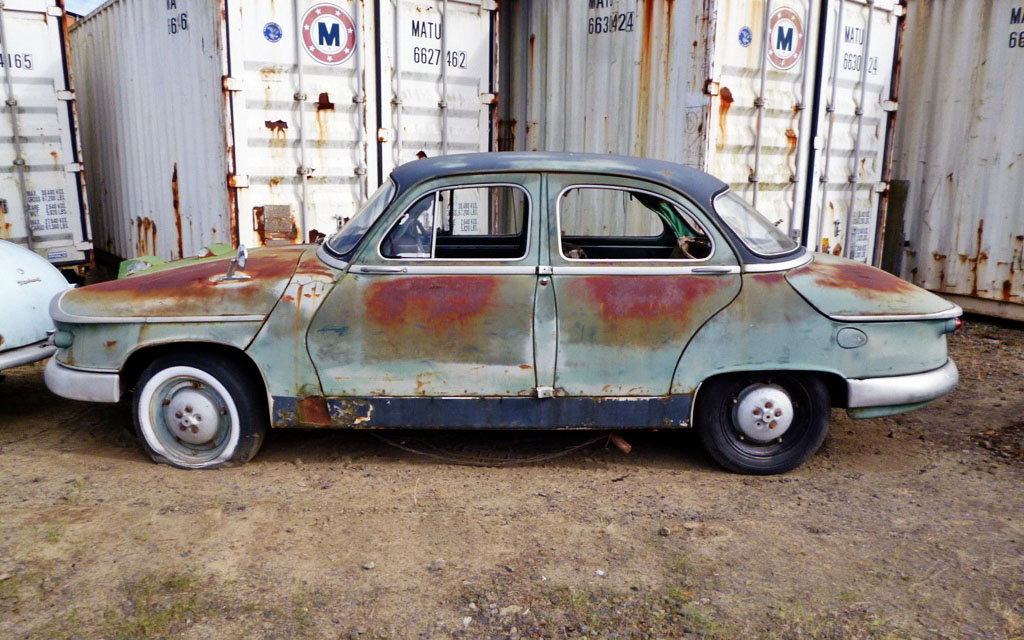
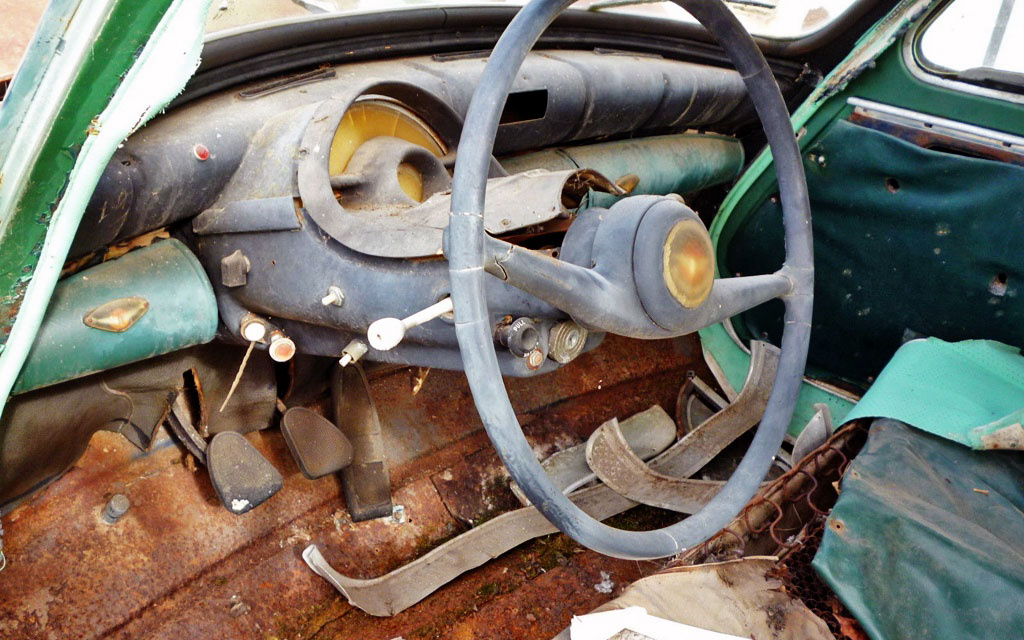
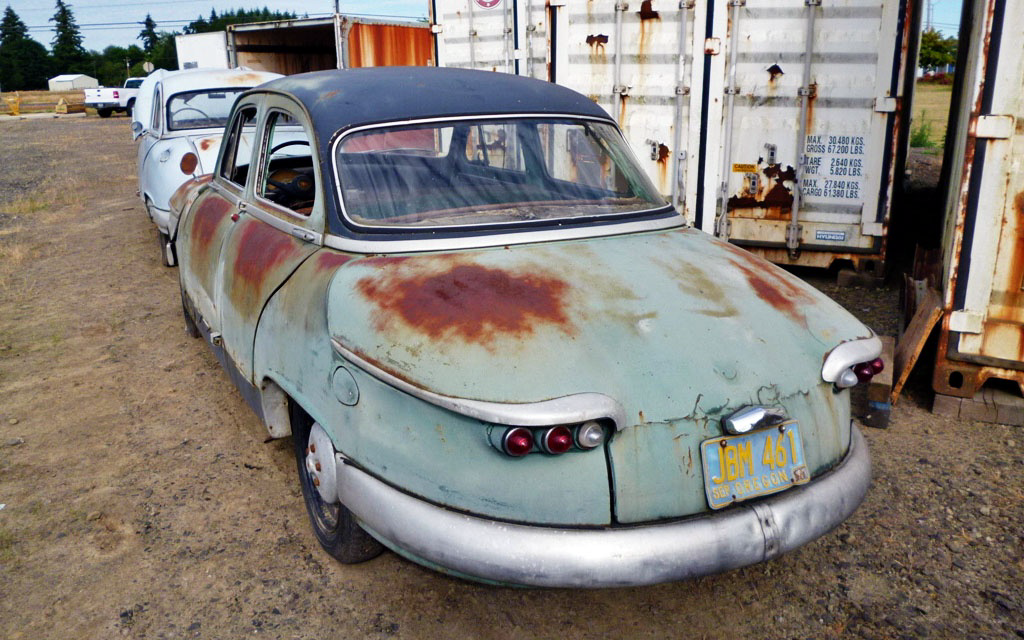

Comments
Truly awful French car. I love it!
I certainly agree with you , shilo ! It is such a wonderfully distinctive looking car . All panhards from the late 1940s onwards until 1967 were the most , well , so french looking ? Just like the citroen Ami and Ds’s contemporary of the time . Where else but from France could such a car as weirdly looking , and all the more fascinating for it in that respect , come
from ? I just adore them !
Seller obviously has a thing for French cars. I see a Citroen Mehari, another Panhard, and a first nose Citroen DS in the background. If he couldn’t find the parts to restore the PL-17 I sure don’t know where I would…
Getting Panhard Dyna parts is mainly a matter of money.
The “Panhard Patent” connecting rod big end bearings are all gone but conventional roller bearings can be used. A motorcycle shop that rebuilds pressed-together crankshafts may be able to disassemble and reassemble the crankshaft if the conrod bearings are too noisy.
The DB-Panhard Club and most Citroën car clubs cover postwar Panhards.
Yep I got to go along with the odd looking car, in fact I’ll even stick my neck out to give these the oddest looking car on the planet….. Someone here in town has a nearly mint one in a cream white & I must say it brings a smile to my face when I see the car at the local car shows.
That is a Panhard Dyna Z parked in front of the Panhard PL17 and a Citroen Mehari parked behind, and another Panhard Dyna with its hood open way in back near the yellow forkilft. Very cool stuff, and very interesting cars. hood scoops on the Pl17 are NOT original! Unfortunately, this will be a very ambitious restoration project.
“The interior is going to need a considerable amount of work…” And that, my friends, will be the least of your problems!
An interesting and unusual car that would be nice to see on the road. It’s a shame, but there probably isn’t anyone with a sufficient combination of both love and money to bring this one back to life.
A modern BMW motorcycle engine might be an interesting power plant.
Installing a BMW motorcycle engine would be quite a project. A cooling fan and ductwork will be a real challenge. The motorcycle engine will be working much harder moving an 1,800# car with 500#+ of passengers and luggage, necessitating much more cooling air flow than the movement of the car will provide.
The original Panhard two-bladed fan with minimal shrouding was insufficient for the 1,400# aluminum bodied car and 40 HP. By 1956 most of the body had been changed to steel. The cooling fan was then a centrifugal “squirrel cage” impeller with much better ducting. Horsepower of all but the base model was 50. The “Tigre” was 60 HP.
I know and love these unusual French cars with the horizontally opposed, air cooled 850cc boxer type engine with torsion bar valve springs and transverse front leaf spring suspension.
They are somewhat difficult to restore because of scarce parts availability, especially here in the states and unfortunately, they are not valuable after being restored.
I have a 1959 Dyns Z16 and I absolutely love it but this will not be easy to restore this on a reasonable budget. Even though I prefer the PL17 model featured here, I am not willing to take this on this project.
I understand that it might have been difficult to find a running panhard engine to replace the original one. But it is a real pity to fit a WW engine. I wonder how they made the connection to the gear box. The panhard design has very particular and outstanding features such as the cranckshaft supported by roller bearings, the valves connected to torsion bars, no cylinders head gaskets. The light wheigt; the motor ahead of the front axle, front wheel drive, gave these car a fascinating road holding. The 850cc two cylindres engine was the first production motor to exceed 100hp by the litre. The last Panhard 24CT in 1967 was given for 94hp with a 850cc engine. Another fascinating feature was, as the room for the gear box was small, the engineers at Panhard used a very simple mechanical equation:
Power equals torque multiplied by angular speed. So they put a gear that made the gear box turn at higher revolution that the engine such allowing to lower the torque and build a smaller gear box on needle bearings. It was necessary, at that time,to be very careful about the oil level in the gear box
There was a special gauge to check lhe oil level in the gear box.
The “special gauge” is called a “dipstick.”
The gearbox is a rather conventional 4 speed then a spiral bevel gear set driven by the output shaft turns a bevel pinion that turns a larger bevel gear on the differential case.
Unlike most if not all other transaxles the secondary shaft is not the output shaft. The step-down gears take care of getting the drive down from the level of the crankshaft to the axle level.
The early boxes were not synchronized on the first and fourth gears. After a few years the fourth gear was synchronized. The ball bearings of earlier boxes were step-by-step changed to needle bearings.
A real curiosity is the use of herringbone gears on the primary shaft to secondary shaft, which was used for 1st, 2d and 4th gears. 3d gear is straight through like most 3 speeds and many 4 and 5 speeds.
The last Dyna 4 door sedan was produced in 1965. All 4 door sedans 1954-65 had the same main body shape. Styling changes were on the hood and rear end.
I agree completely. The installation of the VW engine is a true abomination, even though I understand how it may have been necessary at a time when the cars were not valuable, and before the prior owner could find the proper engine. I am also stumped how they connected the engine to the gearbox as well.
The steering wheel appears identical to a Peugeot 203’s.
No doubt it’s original Panhard and shared between the two, many more 203s were made.
Yes, I agree if the original engine could not be sourced. I have often thought that a BMW R1200RT engine would be amazing in this car, but I doubt that the fragile transmission could handle the torque.
oh ya…………..a Mehari in the background?……….where on earth would parts come from for these cars……………pretty neat looking
The photo of the way the motor is connected to the transaxle is pretty scary but I do admire the backyard ingenuity. This thing is already jacked up enough I say just put a Subaru mill in it and scare the s**t out of people (including yourself).
le Kermit-mobile
Only the French can do that to sheet metal. I guess the result of having wine for breakfast and lunch on work days. As to the pink VW engine, you have to admire the ingenuity, I think it is the only redeeming feature. Get the VW running, check the brakes, throw a blanket on the seat and drive it as is for many varied reactions at shows and gatherings.
I’m sorry, but the installation of this car around a VW engine is the true abomination.
Even rust had the good sense to avoid this thing. On a positive note, I can see where some 1960’s Plymouth Valiants stole their styling cues.
Mon Dieu.
This car is strange to the point that I would feel weird driving it on the road. I’m old enough that this shouldn’t bother me but this car is so very weird that I’d feel like I’m driving an art project. If it was in a nice royal blue with a luxurious tan leather it might look less weird but I don’t really know. This is one car that just isn’t for me like a Renault Fuego or those catfish sp250.
The Panhard pastel lavender pink is more typical.
The main unit body was unchanged 1954-65. Only the engine cover and the trunk lid and walls were restyled. My 1957 Grand Standing looked the same as the 1954 Dyna 54 except for the rust on the steel ’57.
I love those week end car shows where cars of every genre show up. That is where I saw the only Panhard I’ve seen in person. I love them, they’re quirky but only if you can’t see beyond an American automobile experience. There is something wonderful in the design and the technology of these cars that just sings. It saddens me to see this car in this condition and knowing that the best it will probably ever be is a donor. As for that VW engine transplant, all I can say is that now I know how those guys feel that hate to see a small block Chev stuffed into everything.
I see 90% of the comments on here concern the powerplant. If I had to be concerned with the “odd flavor” of it’s looks I would never had an Isetta 300,Subaru 360 or other oddballs(and I’ve had my share of them) but to be 100% honest I’ve had my fill looking at Chevelles,Roadrunners and the like of them.Just as 3 eyed martians turn heads,so would this and this could be your “Martian”.If you enjoy good conversation about automobiles wherever you go this is it.Keep the VW engine as it is cheap to work on if you’re knowledgeable and if you go to church every Sunday maybe an original engine will show up.A simple personal license plate with French or Le Messe would would say it all.
I had a Volvo Amazon with a B18A 75hp engine and a Panhard PL17 with a 50hp engine, but the Panpan was quicker…(very light body, same body demensions)
The engine of the panhard is very difficult to restore.
This was my Dad’s dream car ,but that is as far as it got. I grow up under the impression that the car had an aluminium body. Well , just look at that rust. Live and learn.
1954 through part of 1956 had aluminum bodies. The unit body switched to steel and as aluminum hoods, doors and trunk kids were used up, they went to steel. Bumpers, trim, fuel tanks continued in aluminum.
The engine cylinders, crankcase, transmission case, cooling shrouding remained in aluminum.
Aluminum 1954s and ’55s are very rare in America. Two ’54s were brought in by Alcoa to show what could be done with aluminum. They are, or perhaps were, owned by _________ Cox in Richmond, VA.
I have actually seen this car when it was being stored outside a shed that held a couple of Citoren DSs, an Ami 6, A Traction Avant policier 6 cylinder and another Dyna. This one has been bitched with the installation of a VW Engine.
/Users/genepark/Desktop/DSCN1270.jpg
DSCN1270.jpg
“Once you own a French car, nothing worse can happen to you.”
Except Trabant, Renault Dauphine, Chevy Vega, any Itali-Fiat, Polski-Fiat, Yugo-Fiat, Russki-Fiat, etc.
@Henrie,
You are partially correct. Early Panhards (Dyna Z models) had an all aluminium body shell, but production costs forced Panhard to move to an all steel body in 1857, although they retained the cast aluminium bumpers and trim.
Chas
@ Rex,
Ahhh, someone who remembers “The Theory Of Displaced Misery”.
Even its Mamma would have called this baby ugly.
I love it!
I love this car! Looks sort of like a dim witted hooker with those little lips and eyebrows. Needs only a little more lipstick. I’m with Howell: throw some moving blankets on the seats (and floors, if your feet are cold), slap on some new tires and do a brake job, get it to run and drive it. You’ll never be without animated conversation in your life again.
Maybe a Harley V-twin. Flathead Ford? Might as well have fun.
The engine that went missing is properly described as very advanced. The Deutche-Bonnet sports cars used a hopped up version to power the DB fiberglass racers that did very well in their class at LeMans. Racers in California further developed the engine by fitting Norton Manx big valve heads and were the first to drive cams with toothed Gilmer belts. The engines were real screamers and made the DB specials west coast winners. I passed up buying a DB HBR-5 coupe in the mid 60’s that had an ignition electrical fire after racing at Watkins Glen. The idea of trying to sort out a french electrical system without a manual or wiring diagram was way beyond my skills. At one time the DB HBR-5 coupe held a class record at Bonneville slightly above 90 MPH with the engine turning 10K. The Panhard engine and chassis were not econojunk but superbly engineered light, efficent cars.
@ Chris,
You are correct that the electrical issues can be significant on a Panhard, but they are very basic electrical systems. Curiously the entire car uses no fuses whatsoever, so Panhard must have been extremely confident in their electrical systems.
Also although the engines are superbly engineered, they are quite simple in their design. The issues arise because the engines use a roller bearing crankshaft, and the cranskshafts are no longer available, so they have to be rebuilt.
The Deutsch Bonnets were extremely fast and competitive and won many races with this tiny engine, and Panhards often won the indices of endurance races as well as other competitions. I believe that Panhard may have been one of the first cars to exceed the 100 hp per litre threshold, and the later 24CT may have produced 90 hp from a mere 850cc.
Chas
In the hands of an owner who will properly maintain the engine it is very durable. The original “Panhard Patent” conrod big end roller bearings overcame the roller skidding problem common to other roller bearing crankshafts.
As there was no oil filter, only a fine screen, the manual called for changing the oil every 1,000 kms. (600 miles). It took only one litre of oil.
The original timing gears are of laminated cloth phenolic, which due to its resilience operated with interference against the steel timing pinion for zero backlash. In the USA Pennzoil Pure Pennsylvania would not damage the phenolic gear. I have a brand new one that is only good as a curio as it is over 60 years old. Aluminum timing gears were used by racers from early on, and are all that are to be had now. As the aluminum gear has to have enough backlash to prevent clearance from ever going to zero, the timing gears make a little noise. But with the whirring of the roller bearings and other noises, who would notice?
There is no valve noise on production engines except very early ones as valve lash eliminators operated by oil pressure take up the valve train clearances after a few revolutions of the crankshaft. Oil pressure is 3 psi. Not 30 psi. 3. The roller bearings don’t need any pressure. The oil flows to the main bearings, then slings into gutters on the crank throws and thence into the conrod big end bearings. Roller bearings being intolerant of particles, changing oil on time is imperatives. An accessory bypass filter was available but as automotive oil filters allow any particles less than 30μ to pass on through, regular oil changing is what keeps the roller bearings alive.
the electrical system cannot be worse than any fiat i ever owned. i too would be in favor of a harley vtwin or something like it cause i don’t think it will ever be original again.
Electrical ? Ha! Forty years working with Prince Lucas (of darkness fame) has showed me some impressive haywire…It can’t be worse (can it)
What an odd looking bird.
That side view somehow reminds me of the Plymouth Valiant I had while at Fort Bliss (a misnomer) El Paso 1969.
I have to wonder – what’s the deal with the dual generators on the VW engine?
My guess is that the VW generator died, so an additional generator was installed. The VW cooling fan is on the generator shaft, so even if the generator goes bad, it has to be kept.
It’s worse than ugly. It’s Fugly! I no clue what I would do with it if I owned it. Probably park it in the yard and listen to the wife fuss about it. But I like it…
My only experience with French cars was a 1959 or 60 Renault Dauphine my parents bought new in Denver. Dad traded a BMW Isetta 300 on it. My folks kept a big car, and a little car. Our big car was a 54 Caddy, which begin to break down frequently about the time Dad bought the Renault. We rode from Denver to indianpolis that summer in the Renault and had some problems with it. When we returned to Denver Dad traded it on a BMW 600, which proved to be a cool little car. Later that year, the caddy was traded for a new 1960 Falcon. We had several more Isetta’s over the years, but no more French cars. I don’t think I have ridden in a French car since that time.
Charles
I’ve had the pleasurable opportunity to drive one this past July in France for a 200 mile trip. An amazing car, roomy, comfortable, quiet enough, excellent road manners and thrifty on gas, not to mention how impressed I was with the power band available. Even my wife was impressed. I do agree though that this one is too far gone for me and it brings a smile to my face when I read the seller will part with a new hood….at an extra cost….c’mon, let’s be real!
DL
Ooops. obviously I meant in 1957, Panhard changed fprm aluminium bodies to steel bodies and not in 1857 as I mistakenly typed in my earlier post.
SOLD for $987 with 6 bids! Well bought?
…lucky that it sold, period! The only reason anyone would buy it would be for parts for another Panhard…my opinion.
BD
Not all French cars are bad looking, or bad to own – we had 2 Peugeots that were both reliable and delightful.
Beauty is in the eye of the beholder. In France, Nash Metro’s, Dodge Valiant’s, Studebaker Avanti’s, AMC Gremlins and the like are considered UFO-looking-like vehicles, so there! -disclaimer: save your ammo: I do love those models, as much as the Panhard :-)
G, I’m with you; we have owned 2 Peugeots and we respect the French build quality and performance. Sure, they are “quirky” and not everybody’s cup of tea, but each to their own and they are different to the gas guzzling V8’s that everyone got rid of when gas prices became an issue.
My guess is that the VW generator died, so an additional generator was installed. The VW cooling fan is on the generator shaft, so even if the generator goes bad, it has to be kept.